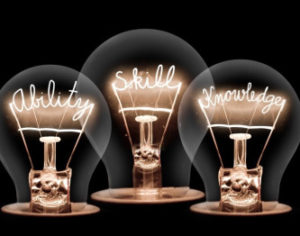
My friend said, “You’re trying to change people’s behavior only from the outside. Lasting change starts on the inside and moves out.”
I knew immediately he was right, because all I had been focusing on were leadership methods and behavior. I hadn’t focused much on what was inside people’s heads or hearts.
Armed with this new insight, I teamed up with Paul J. Meyer and Dick Ruhe to write Know Can Do, a book about how to close the learning-doing gap. Together we developed three simple ways to help people make the leap from knowing to doing.
#1 – Learn Less More (and Not More Less)
While it’s fine to spend energy learning new skills and knowledge, you also need strategies to retain and apply all the helpful information you take in. For example, perhaps you love reading books and attending seminars. There’s nothing wrong with that—unless you do those things so often that you don’t pause to integrate your new know-how and put it into action.
The fact is, we retain only a small fraction of what we read and hear only once. Instead of gobbling up new information, focus on a few key concepts and study them deeply. Then repeat what you’ve learned over time, which is called spaced repetition. This way, the new knowledge becomes firmly fixed in your mind and you become a master in those areas.
#2 – Listen with a Positive Mindset
There’s nothing wrong with thinking critically; in fact, it’s essential for survival. However, many if not most of us did not receive unconditional love and support when we were young. This gives us a tendency to doubt ourselves and others. Self-doubt causes us to filter all information—whether in book, audio, video, seminar, or conversation format—through our indecisive, closed-minded, judgmental, fear-ridden mindset, which leads to negative thinking.
Negative thinking causes us to learn and use only a fraction of what we see and hear. As a result, we achieve only a small percentage of what we could achieve. We accept too little too soon.
A positive, open mind ignites creativity, ingenuity, and resourcefulness. Instead of trying to find what’s wrong with new information, be a green light thinker who actively seeks out what’s right. Practice saying to yourself, “I know there is something of value in what I’m reading or hearing; what is it?”
#3 – Use a Follow-Up Plan
Doing what you’ve learned cannot be left to chance. To keep and apply the knowledge you’ve gained, you need a follow-up plan that provides structure, support, and accountability.
For example, suppose you’ve been out of shape most of your life, but thanks to your newfound positive thinking, you just finished a session with a personal trainer at the gym. You’re feeling proud of yourself—but you don’t have a follow-up plan. What do you think is going to happen in the coming weeks and months? Chances are good to great that you’ll revert to your old ways.
Follow-up plans can take many forms, but the best ones include someone who can tell you, show you, observe you, and praise your progress or redirect you as you practice the new skill. Don’t let your teacher skip the praise part of that sequence, because accentuating the positive motivates learners. Soon you’ll be able to praise and redirect yourself. Over time, you’ll become a master in that skill.
And what’s the best way to maintain that mastery? By teaching what you’ve learned.
So, put the knowledge you’ve just gained into action by reviewing this blog with a positive mindset, practicing these steps, and sharing them with others!